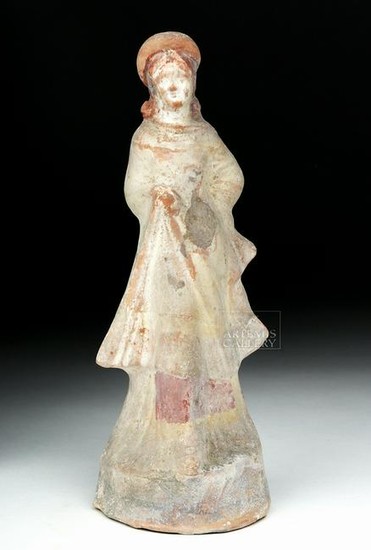Greek Canosan Polychrome Female Figure, ex-Bonhams
**Originally Listed At $1500**
Magna Graecia, Apulia, Canosan Hellenistic Period, ca. 3rd century BCE. A fantastic mold-made terracotta votive figure depicting a standing woman, probably a goddess. Canosa, or Canosion as it was known then, was a major center of the ceramics and pottery trade when it was a Greek polis. It produced truly unique pottery, adorned by a completely different decorative technique from earlier and neighboring traditions. The clay is buff, with the painted decoration applied directly to it without the use of slip. This figure displays remaining painted surfaces on her coiffure, diadem, face, chiton, and hand - in red, white, orange, and black hues. Size: 9.375" H (23.8 cm)
Female figures like this one played an interesting role in Canosan funerary practices. They were placed into Canosan tombs as replacements for large red-figure kraters from the century before, but first, mourners carried them in funerary processions and kept them present while they carried out rituals at the tomb. Virtually all of the statues known from Canosan tombs depict women; however, scholars believe that they represented goddesses or mourners, rather than the gender of the deceased, for in this society, young women played a major role as mourners. The Canosans, like other members of Classical society, believed that the spirits of the dead remained at the tomb and watched over the living. Canosan tombs were re-opened frequently to bury members of the same lineage, and so these figures were probably reused as well, maintaining the connection between the living and the dead.
Provenance: private Houston, Texas, USA collection; ex-Bonham's London Antiquities Auction, 8 May, 2013, part of lot 157; ex-Joseph Klein collection, formed in New York, New York, USA between 1941 and 1980, thence by descent
All items legal to buy/sell under U.S. Statute covering cultural patrimony Code 2600, CHAPTER 14, and are guaranteed to be as described or your money back.
A Certificate of Authenticity will accompany all winning bids.
We ship worldwide to most countries and handle all shipping in-house for your convenience.
#132936
Condition Report: Normal surface wear though some pigment remaining on the surfaces as shown. Abraded area to back of head/coiffure and minor stains to front and back of figure. Otherwise very good with nice root marks on interior.
View it on
Estimate
Time, Location
Auction House
**Originally Listed At $1500**
Magna Graecia, Apulia, Canosan Hellenistic Period, ca. 3rd century BCE. A fantastic mold-made terracotta votive figure depicting a standing woman, probably a goddess. Canosa, or Canosion as it was known then, was a major center of the ceramics and pottery trade when it was a Greek polis. It produced truly unique pottery, adorned by a completely different decorative technique from earlier and neighboring traditions. The clay is buff, with the painted decoration applied directly to it without the use of slip. This figure displays remaining painted surfaces on her coiffure, diadem, face, chiton, and hand - in red, white, orange, and black hues. Size: 9.375" H (23.8 cm)
Female figures like this one played an interesting role in Canosan funerary practices. They were placed into Canosan tombs as replacements for large red-figure kraters from the century before, but first, mourners carried them in funerary processions and kept them present while they carried out rituals at the tomb. Virtually all of the statues known from Canosan tombs depict women; however, scholars believe that they represented goddesses or mourners, rather than the gender of the deceased, for in this society, young women played a major role as mourners. The Canosans, like other members of Classical society, believed that the spirits of the dead remained at the tomb and watched over the living. Canosan tombs were re-opened frequently to bury members of the same lineage, and so these figures were probably reused as well, maintaining the connection between the living and the dead.
Provenance: private Houston, Texas, USA collection; ex-Bonham's London Antiquities Auction, 8 May, 2013, part of lot 157; ex-Joseph Klein collection, formed in New York, New York, USA between 1941 and 1980, thence by descent
All items legal to buy/sell under U.S. Statute covering cultural patrimony Code 2600, CHAPTER 14, and are guaranteed to be as described or your money back.
A Certificate of Authenticity will accompany all winning bids.
We ship worldwide to most countries and handle all shipping in-house for your convenience.
#132936
Condition Report: Normal surface wear though some pigment remaining on the surfaces as shown. Abraded area to back of head/coiffure and minor stains to front and back of figure. Otherwise very good with nice root marks on interior.



